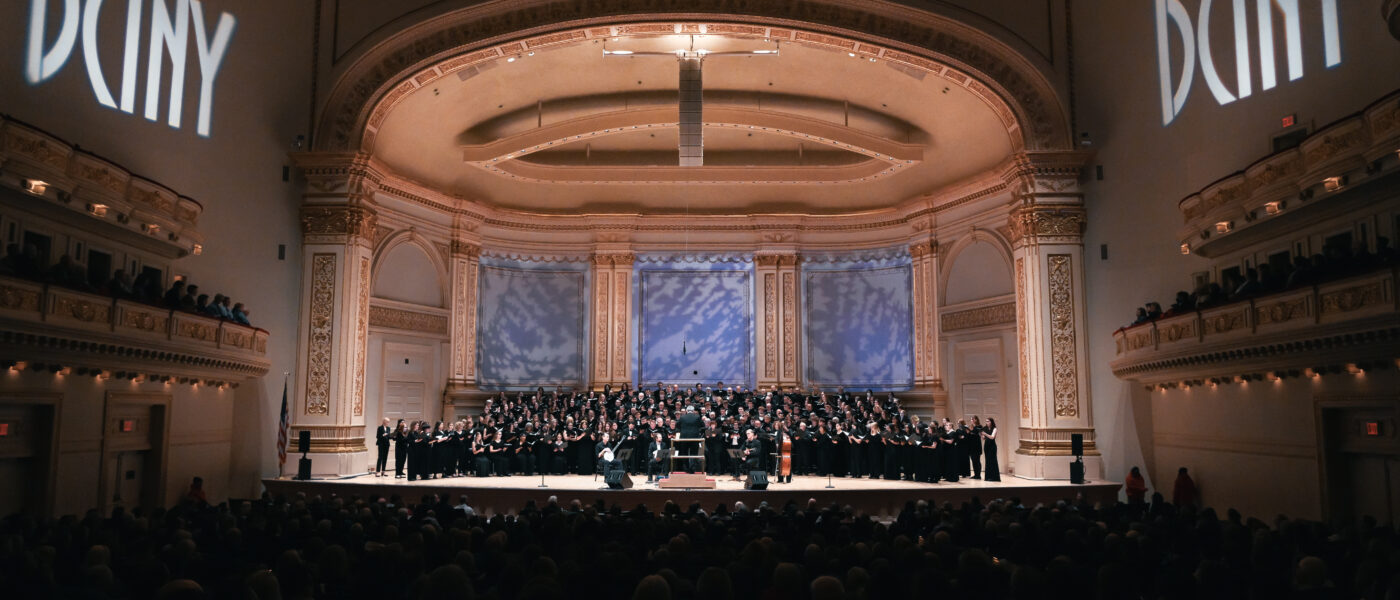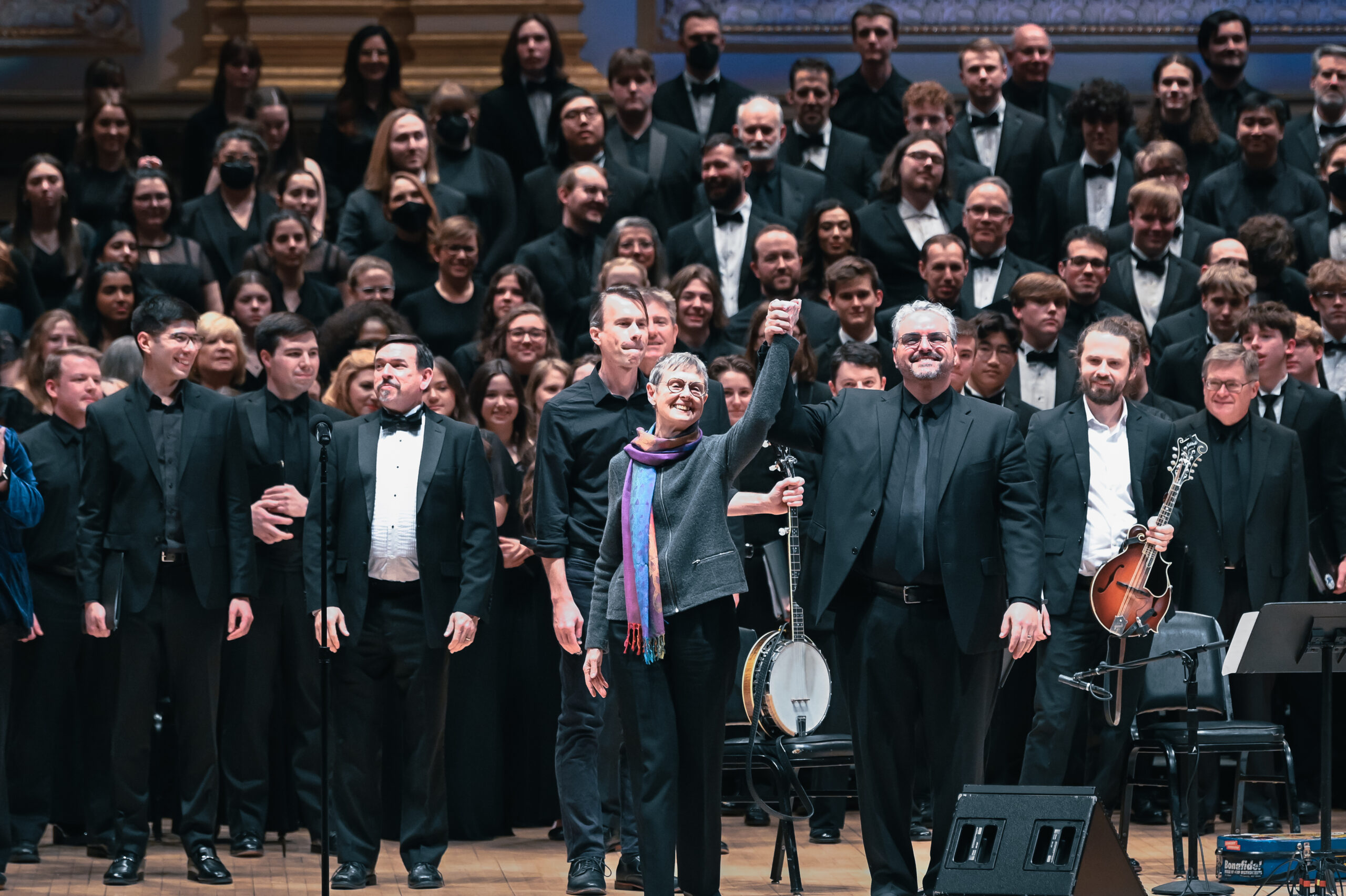Distinguished Concerts International New York (DCINY) Presents Bluegrass Mass in Review
Distinguished Concert Singers International; Tucker Biddlecombe, guest conductor
Downtown Voices; guest conductor, Stephen Sands
Elizabeth Bates, soprano
Gabe Terraciano, fiddle; Jacob Joliff, mandolin; Charles Butler, banjo; Jerry Kimbrough, guitar; Mimi Jones, bass
Stern Auditorium, Carnegie Hall, New York, NY
Sunday February 18, 2024
A large and enthusiastic crowd was present at Carnegie Hall this Sunday for yet another impressive program by Distinguished Concerts International New York (DCINY) entitled “Bluegrass Mass” – named for just one of several powerful works they presented. DCINY has developed the knack for streamlining their massive undertakings, with seamless exits and entrances by hundreds of singers (and no intermission), so this concert, which lasted just one hour and contained just four works (three shorter, followed by the longer Bluegrass Mass) still felt jam-packed with enough music to ponder for a lifetime.
The program opened with three works sung by New York City’s very own chorus, Downtown Voices (a group of sixty-plus singers from a quick count), which combines voices from the Choir of Trinity Church Wall Street along with high-level volunteers. Downtown Voices sang three works, starting with a movement from Akathist by rising star Benedict Sheehan, moving on to Arnold Schoenberg’s Friede auf Erden (Peace on Earth) Op. 13, and closing their selections with Rachmaninoff’s sublime and moving “Bogorioditse Devo” from the All-Night Vigil Op. 37.
If this reviewer were primarily a choral musician, the composer Benedict Sheehan would surely have been a familiar name before this concert, as he is a two-time Grammy nominee and prizewinner whose proponents have recently included the stellar group Voces8; as an introduction, however, his uplifting composition spoke for itself. The Downtown Voices’ rendition of “In the Wondrous Blending of Sounds” the central movement from his larger work, Akathist, was simply breathtaking. Based on what Mr. Sheehan refers to as a “gently ornamented melody inspired by South African folk music” it was a perfect start to a program filled with references to peace and prayer amidst an often opposing reality. The choir projected its luminous harmonies with polish, thanks to the expert conducting of Maestro Stephen Sands, who led them from the movement’s faint beginnings into its full bloom. Soloist Elizabeth Bates contributed her pure senza vibrato soprano in one section, which intensified its hallowed feeling. The composer was present for a well-deserved bow from the balcony.
Arnold Schoenberg’s Friede auf Erden, Op. 13 (composed from 1906-1911 and premiered in 1911), provided just the right ballast amid such highly ethereal music. It is based on a poem by Conrad Ferdinand Meyer (1886), which despite its Christmas origins is filled with gritty reality and darkness. The music teeters accordingly between faith and desperation. A challenging and dissonant piece to sing (and originally premiered with orchestra for the purpose of keeping singers on course), it was sung here as originally written, a cappella. Any fleeting awkwardness in pitch only served to intensify the emotion of the piece, which ends in somewhat tenuous harmony, presumably reflective of the composer’s sentiments and those of many today. As Schoenberg wrote (1928), “It is perhaps correct that one must be religious in order to compose church music, or in love in order to compose love songs […], but still one must certainly not be wounded in order to portray a wounded person or dying in order to portray a dying person. And so it would certainly be possible to compose a peace hymn without believing in an eternal peace.” Sigh.
Especially on that note, the Rachmaninoff “Bogorioditse Devo” came as a balm in the program. One of this reviewer’s favorite pieces to begin with, it was given an extremely sensitive performance, vibrant with tonal colors. Its enormous dynamic range took one from gripping forte levels, enhanced by an especially fine bass section, to exquisite pianissimo levels, approached with masterful nuance. Bravi tutti!
After these three exceptional performances came the balance of the program, Carol Barnett’s The World Beloved: A Bluegrass Mass, for which the concert was given its title. Though the chorus Downtown Voices did not leave the stage, they were joined by several hundred more singers constituting the Distinguished Concerts Singers International, led by DCINY Guest Conductor Tucker Biddlecombe. These two hundred or so singers combined the forces of the GPS Singers, Dubuque Chorale, McCallie Men’s Chorus, Green Hope High School Voices Of Hope, Nashville Symphony Chorus, SMS Heritage Singers, Northport High School Tour Choir, and as always with DCINY “individual singers from across the globe.” As they quickly filed onto the Perelman stage, one could hear the discreet tunings of five bluegrass instrumentalists, Gabe Terraciano (fiddle), Jacob Joliff (mandolin), Charles Butler (banjo), Jerry Kimbrough (guitar), and Mimi Jones (bass).
As the composer Carol Barnett states herself, “To bring the solemnity of the classical choir-based mass together with the down home sparkle of bluegrass – now there’s an assignment for a composer!” Together with librettist Marisha Chamberlain, Ms. Barnett has done just about that. The work’s twelve sections, some in Latin as with the traditional mass, were woven expertly among more folklike movements of colloquial texts, and with the help of the five excellent bluegrass instrumentalists, there was music of intense syncopation, strong rhythms, and freewheeling fiddle licks. Maestro Biddlecombe was masterful in uniting the huge combined choir.
Though my colleagues have reviewed this mass for New York Concert Review starting over a decade ago, this was my first hearing, and I am happy to say that I thought it worked beautifully overall. From the opening Ballad, rather straight and sung with an unnamed soprano soloist, it kicked into high gear for the ensuing Kyrie with the help of bassist Mimi Jones. The whole bluegrass “band” (though not given a group name and presumable ad hoc freelancers) made a celebration of the fourth movement, Gloria, and it was a singular treat to hear for the very first time the “plenio sunt coeli” text sung in swing rhythm in the Sanctus. Other highlights included some expert mandolin playing in the Credo and the singing by several other unnamed soloists.
With of course no disrespect at all to bluegrass, the style sometimes (via banjo twanging and folksy rhythms) can evoke associations that run counter to the heft of a text, and that fact came to the fore primarily in the eighth movement where mention of the falling of towers and the voice of God seemed to cry out for more of what the composer herself calls “the solemnity of the classical choir-based mass” – and less of what she calls “the down home sparkle of bluegrass” (a matter of timing). Though we know that the voice of God need not be a basso profundo (and in fact in the twelfth movement God is described as a She) – and we also know that the idea is meant to be of God coming down as a mere mortal – still, one craved the sense of omnipotence at the heart of more traditional masses. This reviewer found herself at times searching for it. Otherwise, the work as a whole came off as a remarkable achievement.
The audience gave a rousing ovation, undoubtedly for performers and composers alike – in addition to the various choral directors who also took a bow. As usual, DCINY is to be congratulated.


